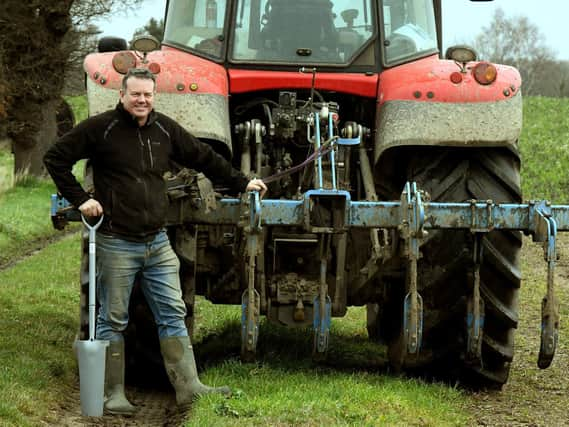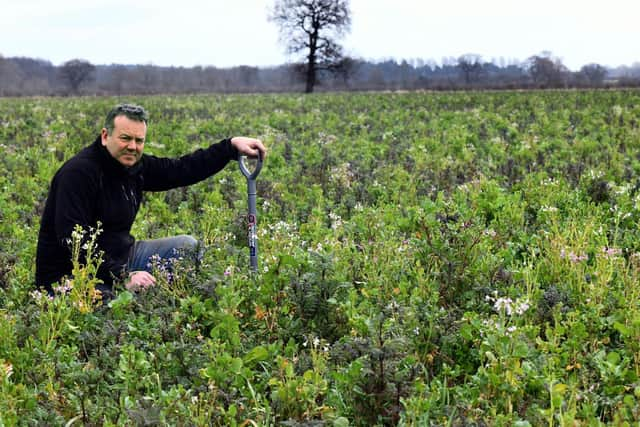Arable farmer wins award for carbon sequester through cover crops


The trophy was for his work with cover crops at his home, Manor Farm. Cover crops are planted not to become a cash crop, but rather to prevent erosion of the soil, improve the soil’s biological and physical properties, supply nutrients, suppress weeds, encourage wildlife and also sequester carbon through the cover crop absorbing carbon dioxide.
Cover crops not only improve the soil, another major worldwide topic, but provide improved wildlife habitat and bring the probability of increased yield at harvest when the cash crop is grown.
Advertisement
Hide AdAdvertisement
Hide AdBut, as have many farmers, Richard has had a lot to contend with. His farmhouse was flooded and half of his winter wheat crop was destroyed shortly after Storm Ciara and this brought the number of times his farm has been flooded up to 11 since taking over from his father.


Something he said happened far less during his father’s tenure and which he believes is down to climate change.
The 500-acre farm grows milling wheat, malting barley, sugar beet, potatoes, oilseed rape and beans and Richard has much to do when his land eventually dries out, which could take another fortnight.
“Weather patterns have changed, and I’m convinced that’s on the back of climate change,” he said.
“Extremes are no longer the extreme, they are now the norm.
Advertisement
Hide AdAdvertisement
Hide Ad“Although we’re a long way from the sea, the Ouse is tidal and here we have the confluence of the Ouse and Wharfe, one of the fastest moving catchments in the country.
“When there’s a lot of rain from the Wharfe we tend to get it here. The land is a designated washland to store floodwater to protect Selby and Cawood, for which we receive no recompense when the crop is affected.
“Our land is very fertile with various grades from silty clay loam on the land that floods to sandy loam typical of the Vale of York and a combination of stuff that blows to claggy clay.
It’s a productive farm. Last year we averaged 4.2 tonnes of wheat per acre and 5,000 tonnes of produce overall from the farm acreage.
Advertisement
Hide AdAdvertisement
Hide Ad“I started with cover crops in 2007 but ‘green manures’, the effective product of a cover crop, were used by farmers years ago. Farmers have always understood the benefit of a rotation and have always been attentive to looking after and managing the soil, but haven’t necessarily had the knowledge or understanding to do something about it.
“We now have far greater access to better science and understand that you don’t just put a seed into the ground and it grows into a plant you harvest, there’s an awful lot more going on underground where there is interaction between the plant and everything else that is going on in the soil.
“There are something in the order of five tonnes of living microbes/bugs in every hectare of top soil. It’s like having 100 sheep walking about. All these things can make a huge difference to a crop and can improve soil structure.”
Cover crops are generally not taken to harvest, they are to provide a continuity for the soil, cover for when there is no cash crop sown and as cover for wildlife.
Advertisement
Hide AdAdvertisement
Hide AdThey are also highly effective as storers of carbon, absorbing carbon dioxide and improving the soil’s organic matter.
“I have a rotation of around five to seven different crops around the farm and quite often when you harvest a crop there is a gap before the next crop can go in.
“This is where soil management comes in, where the land is available to do something.
“You can do nothing, or you can put in cover crops to fill that gap, as I do, with oats, phacelia; oil radish and buckwheat; and legumes – berseem clover and vetch. These all trap nitrogen from the atmosphere and boost fertility, they each bring something to the party.
Advertisement
Hide AdAdvertisement
Hide Ad“Cover crops are now a normal part of our farm, they’re not something extra I try to fit in. Primarily, I’m using them before spring crops rotating around the farm, 25 per cent of the farmed area has a cover crop in each year, that’s how important they are to the soil and to our commitment towards farming moving to carbon neutral in years to come.
“Fields that previously had an issue have improved as a result.
“The really positive thing is that as farmers we are getting a handle on cover crops and other areas such as the planting of hedges that also act as a carbon sink.
“New government schemes, in theory, are intended to reward us for the work that we do that we don’t market – hedgerow planting, landscape management, habitat creation.
Advertisement
Hide AdAdvertisement
Hide Ad“Carbon management might be part of that too and at last week’s Carbon conference I expressed to my fellow farmers to be mindful that we don’t sell ourselves short on the carbon story.
“We also have to measure the good work. We can talk all we like but we need evidence and figures to quantify it.
“Steve Cann and his team who organised the conference, calculated from the weight of our cover crop how much carbon had been sequestered. That’s what we all need to do.”